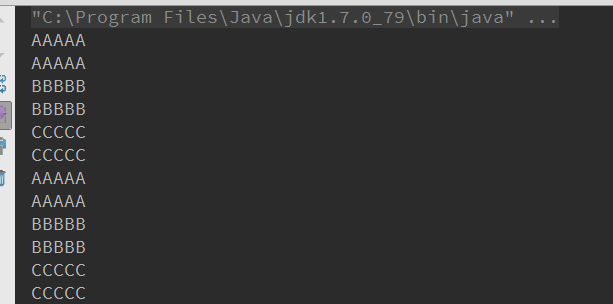本文实例讲述了java实现指定线程执行顺序的三种方式。分享给大家供大家参考,具体如下:
方法一:通过共享对象锁加上可见变量来实现。
|
1
2
3
4
5
6
7
8
9
10
11
12
13
14
15
16
17
18
19
20
21
22
23
24
25
26
27
28
29
30
31
32
33
34
35
36
37
38
39
40
41
42
43
44
45
|
public class myservice { private volatile int ordernum = 1; public synchronized void methoda() { try { while (ordernum != 1) { wait(); } for (int i = 0; i < 2; i++) { system.out.println("aaaaa"); } ordernum = 2; notifyall(); } catch (interruptedexception e) { e.printstacktrace(); } } public synchronized void methodb() { try { while (ordernum != 2) { wait(); } for (int i = 0; i < 2; i++) { system.out.println("bbbbb"); } ordernum = 3; notifyall(); } catch (interruptedexception e) { e.printstacktrace(); } } public synchronized void methodc() { try { while (ordernum != 3) { wait(); } for (int i = 0; i < 2; i++) { system.out.println("ccccc"); } ordernum = 1; notifyall(); } catch (interruptedexception e) { e.printstacktrace(); } }} |
|
1
2
3
4
5
6
7
8
9
10
11
12
|
import service.myservice;public class threadaa extends thread { private myservice dbtools; public threadaa(myservice dbtools) { super(); this.dbtools = dbtools; } @override public void run() { dbtools.methoda(); }} |
|
1
2
3
4
5
6
7
8
9
10
11
12
|
import service.myservice;public class threadbb extends thread { private myservice dbtools; public threadbb(myservice dbtools) { super(); this.dbtools = dbtools; } @override public void run() { dbtools.methodb(); }} |
|
1
2
3
4
5
6
7
8
9
10
11
|
import service.myservice;public class threadcc extends thread { private myservice dbtools; public threadcc(myservice dbtools) { this.dbtools = dbtools; } @override public void run() { dbtools.methodc(); }} |
|
1
2
3
4
5
6
7
8
9
10
11
12
13
14
15
16
17
|
import extthread.threadcc;import service.myservice;import extthread.threadaa;import extthread.threadbb;public class run { public static void main(string[] args) { myservice myservice = new myservice(); for (int i = 0; i < 2; i++) { threadbb output = new threadbb(myservice); output.start(); threadaa input = new threadaa(myservice); input.start(); threadcc threadcc = new threadcc(myservice); threadcc.start(); } }} |
执行结果:

可以看到线程的启动按顺序执行了。共享对象锁,可以保证每个方法只能同时有一个线程进入,配合wait和notifyall方法,可以启动或者唤醒线程。
方法二:通过主线程join()
|
1
2
3
4
5
6
7
8
9
10
11
12
13
14
15
16
17
18
19
20
21
22
23
24
25
26
27
|
class t11 extends thread { public void run() { system.out.println("in t1"); }}class t22 extends thread { public void run() { system.out.println("in t2"); }}class t33 extends thread { public void run() { system.out.println("in t3"); }}public class test2 { public static void main(string[] args) throws interruptedexception { t11 t1 = new t11(); t22 t2 = new t22(); t33 t3 = new t33(); t1.start(); t1.join(); t2.start(); t2.join(); t3.start(); }} |
方法三:通过线程执行时join()
|
1
2
3
4
5
6
7
8
9
10
11
12
13
14
15
16
17
18
19
20
21
22
23
24
25
26
27
28
29
30
31
32
33
34
35
36
37
38
39
40
41
42
43
44
45
46
47
48
49
|
class t1 extends thread { public void run(){ random random = new random(); try { thread.sleep(random.nextint(1000)); } catch (interruptedexception e) { e.printstacktrace(); } system.out.println("in t1"); }}class t2 extends thread{ private thread thread; public t2(thread thread) { this.thread = thread; } public void run(){ try { thread.join(); } catch (interruptedexception e) { e.printstacktrace(); } system.out.println("in t2"); }}class t3 extends thread{ private thread thread; public t3(thread thread) { this.thread = thread; } public void run(){ try { thread.join(); } catch (interruptedexception e) { e.printstacktrace(); } system.out.println("in t3"); }}public class test { public static void main(string[] args) throws interruptedexception { t1 t1 = new t1(); t2 t2 = new t2(t1); t3 t3 = new t3(t2); t2.start(); t1.start(); t3.start(); }} |
希望本文所述对大家java程序设计有所帮助。
原文链接:https://blog.csdn.net/difffate/article/details/63684290













